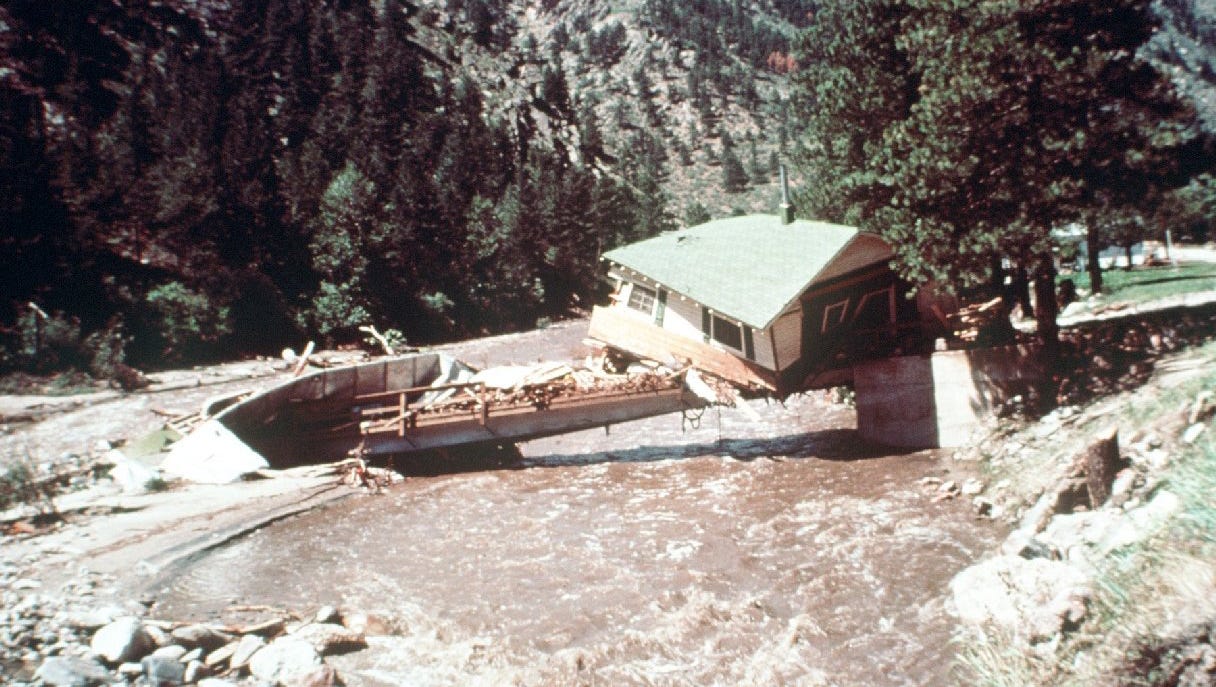Natural Disasters Disasters
The Big Thompson River is a tributary of the South Platte River, approximately 78 miles (123 km) long, in the U.S. state of Colorado.
On July 31, 1976, during the celebration of Colorado's centennial, the Big Thompson Canyon was the site of a devastating flash flood that swept down the steep and narrow canyon, claiming the lives of 143 people, 5 of whom were never found. This flood was triggered by a nearly stationary thunderstorm near the upper section of the canyon that dumped 300 millimeters (12 inches) of rain in less than 4 hours (more than 3/4 of the average annual rainfall for the area). Little rain fell over the lower section of the canyon, where many of the victims were.
Around 9 p.m., a wall of water more than 6 meters (20 ft) high raced down the canyon at about 6 m/s (14 mph), destroying 400 cars, 418 houses and 52 businesses and washing out most of U.S. Route 34. This flood was more than 4 times as strong as any in the 112-year record available in 1976, with a discharge of 1,000 cubic meters per second (35,000 ft³/s).
In 2008, a man who was thought to have died in the flood was found to be alive and living in Oklahoma. Daryle Johnson and his family had rented a cabin east of Estes Park, but left without telling anyone on the morning of July 31. A woman who was researching the flood's victims discovered he was still alive.
The canyon was just one of the many areas along the Front Range that were devastated in the September 2013 flood. While not as intense as the 1976 flood, the storms that caused the flooding in 2013 still sent enough water down the canyon to wash out the highway in many places. The flood also damaged the US Bureau of Reclamation's Dille Diversion Dam. The biggest infrastructure casualty, however, was the City of Loveland's hydroelectric plant (rebuilt after the 1976 flood); the Idylwilde Reservoir was completely filled with silt and rocks, the Idylwilde Dam broke free of the bedrock, and the hydroelectric plant in the Viestenz-Smith Mountain Park was filled with water and silt. The dam was in the process of being relicensed with the FERC, but it was instead demolished, the dam material and contents of the reservoir being used as fill for highway repairs. The park is currently being redone in such a way to better withstand future flooding. More details
Around 9 p.m., a wall of water more than 6 meters (20 ft) high raced down the canyon at about 6 m/s (14 mph), destroying 400 cars, 418 houses and 52 businesses and washing out most of U.S. Route 34. This flood was more than 4 times as strong as any in the 112-year record available in 1976, with a discharge of 1,000 cubic meters per second (35,000 ft³/s).
In 2008, a man who was thought to have died in the flood was found to be alive and living in Oklahoma. Daryle Johnson and his family had rented a cabin east of Estes Park, but left without telling anyone on the morning of July 31. A woman who was researching the flood's victims discovered he was still alive.
The canyon was just one of the many areas along the Front Range that were devastated in the September 2013 flood. While not as intense as the 1976 flood, the storms that caused the flooding in 2013 still sent enough water down the canyon to wash out the highway in many places. The flood also damaged the US Bureau of Reclamation's Dille Diversion Dam. The biggest infrastructure casualty, however, was the City of Loveland's hydroelectric plant (rebuilt after the 1976 flood); the Idylwilde Reservoir was completely filled with silt and rocks, the Idylwilde Dam broke free of the bedrock, and the hydroelectric plant in the Viestenz-Smith Mountain Park was filled with water and silt. The dam was in the process of being relicensed with the FERC, but it was instead demolished, the dam material and contents of the reservoir being used as fill for highway repairs. The park is currently being redone in such a way to better withstand future flooding. More details

